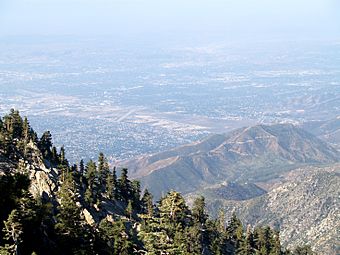Cucamonga Valley AVA facts for kids
| Wine region | |

View of the Cucamonga Valley AVA from Cucamonga Peak
|
|
| Type | American Viticultural Area |
|---|---|
| Year established | 1985 |
| Country | United States |
| Part of | California, South Coast AVA |
| Climate region | Mediterranean |
| Size of planted vineyards | 1,000 acres (4 km2) |
| Grapes produced | Aleatico, Alicante Bouschet, Cabernet Franc, Cabernet Sauvignon, Chasselas, Grenache, Merlot, Mission, Mourvedre, Palomino, Pedro Ximenes, Petite Sirah, Syrah, Zinfandel |
The Cucamonga Valley AVA is a special area in San Bernardino County, California. It is known for growing grapes for wine. This valley is part of the Pomona Valley. It is about 15 miles (24 km) west of San Bernardino.
The Cucamonga Valley has a very warm climate. Summer temperatures often go above 100 °F (38 °C). The ground here is sandy, which is good for grapevines. Sometimes, a plant disease called Pierce's disease can affect the grapevines.
In 1995, the Cucamonga Valley became an official AVA. This happened because Gino L. Filippi and local grape growers asked for it. Being an AVA means wineries can put "Cucamonga Valley" on their wine labels. But they must use at least 85% of grapes grown in this valley.
A Look Back: History of Grape Growing
People started growing grapes in the Cucamonga Valley in 1838. Tiburcio Tapia began this on his Rancho Cucamonga. This was a large piece of land in Alta California. In 1859, a rancher named John Rains planted many vines. He helped farming grow in the area. Before this, people mostly raised cattle and sheep.
By 1917, the Cucamonga-Guasti vineyards were huge. They covered over 20,000 acres. Secondo Guasti even said his vineyard was "The Largest in the World."
When Prohibition began in 1920, the Cucamonga Valley was a major grape producer. It grew more wine grapes than Napa County and Sonoma County combined. Some famous wineries were in the area. These included the Mission Vineyard winery, later called Virginia Dare Winery. Others were Thomas Brothers Winery and G. Filippi and Son Winery.
After Prohibition ended in 1933, farming in the valley faced challenges. Cities like Los Angeles and Orange County began to grow. Many families moved to the Cucamonga Valley. They were looking for affordable homes. This led to a lot of farmland being used for houses.
Today, places like the Joseph Filippi Winery & Vineyards are working hard. They are helping to bring winemaking back to the Cucamonga Valley.
Wineries in the Valley
| Name | City | Year of Creation |
|---|---|---|
| Galleano Winery | Mira Loma, CA | 1927 |
| Joseph Filippi Winery & Vineyards | Rancho Cucamonga, CA | 1922 |
| Rancho De Philo Winery | Rancho Cucamonga, CA | 1974 |

